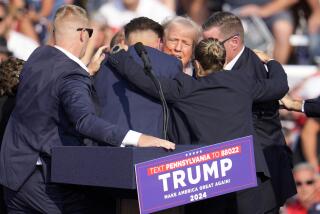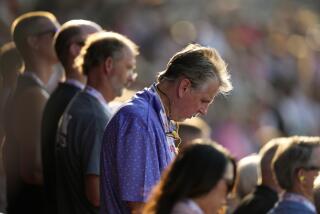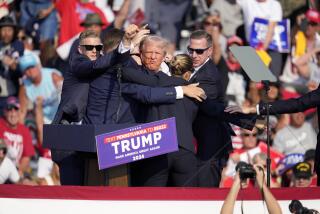Karzai Discerns Al Qaeda in Shooting
KABUL, Afghanistan — President Hamid Karzai said Friday that an assassin who tried to kill him the day before “had links to Al Qaeda,” but he vowed that neither the shooting nor a car bombing that killed at least 24 Afghans here would divert his country from its road to recovery.
At the same time, Karzai said the two attacks Thursday were the acts of isolated individuals and “do not indicate serious problems” in his nation.
“Generally our security is good,” he said.
“But we should not forget that terrorists are active,” Karzai said. The bombing “proves that enemies of Afghanistan do not want us to live in security.”
Despite Karzai’s assertion that the attacks were carried out by individuals, Afghan officials said that at least 14 people had been detained in connection with the assassination attempt.
On Thursday, a recently hired bodyguard for an Afghan governor fired on Karzai in the southern city of Kandahar, narrowly missing the transitional president. U.S. Army Special Forces bodyguards, who have been helping protect Karzai since July, killed the gunman. Two other Afghans--a bystander and a bodyguard who was trying to subdue the assailant--died in the shootout.
The assassination attempt followed by several hours two bomb blasts here in Kabul, the capital. The first bomb, hidden on or under a bicycle, injured one or two people and drew a crowd of onlookers; the second, three minutes later, exploded in a parked taxi and killed at least 24 people.
The city remained tense Friday, and signs of increased security were evident at several locations.
Officials released no details to suggest that the two events Thursday were linked, but several said they believed that Al Qaeda and the remnants of the deposed Taliban regime were involved.
Interior Minister Taj Mohamad Wardak said in an interview that the car bomb might have been aimed at him and another high-ranking government official who had been staying in a hotel beside the bomb site. The two men were not present when the blasts occurred.
Wardak and his family had checked out of the Spinzar Hotel and moved to a house in a residential district in Kabul just half an hour before the blasts. Vice President Nematullah Shahrani also was a regular guest at the hotel but had left Afghanistan for a visit to New York.
Wardak said officials had arrested one suspect in connection with the bombing and were seeking another suspect, the owner of the taxi. Identification left in the twisted wreckage had given investigators hope of capturing him.
Wardak suggested that the suspect being sought had ties to Osama bin Laden’s Al Qaeda terrorist network. But the minister declined to identify the suspect.
“Not every suspect has it written in his driver’s license that he’s with Al Qaeda,” he said when asked for details. “There are different kinds of evidence.”
At the Pentagon on Friday, officials described the bombing as a terrorist attack designed to maximize the killing of civilians. They would not say whether they believed that it was related to the attempt to assassinate Karzai.
But Pentagon spokeswoman Victoria Clarke said the attacks were “clearly designed to undermine the efforts of the Afghan people and the Afghan government to get the country back up on its feet.”
“We do know that there are Taliban remnants, as well as Al Qaeda, who have been plotting these sorts of attacks,” Clarke said. “And these are exactly the sorts of tactics we associate with those organizations.”
U.S. military officials said the attack on Karzai had not altered the recent decision to hand over responsibility for his security from the U.S. Special Forces to the State Department’s Diplomatic Security Service at the end of the month. U.S. soldiers joined the bodyguard detail after the slaying of Afghan Vice President Haji Abdul Qadir in July.
A top global security consultant, meanwhile, said there is little more that the Green Berets protecting Karzai can do while still allowing him to appear in public. He said the level of protection rivals that of President Bush.
“Believe me, they have treated Mr. Karzai as a significant threat-prone protectee,” said Jeff Schlanger, who heads the security services group at Kroll Inc., an international security consulting and private investigation firm. “There was never any question that he is a prime target.”
Afghan officials have identified the slain gunman as Abdul Rahman, 22, of Helmand province, who had been hired three weeks earlier to protect Kandahar Gov. Gul Agha Shirzai. A U.S. bodyguard and Shirzai were injured in the attack, but not seriously.
Discussing the assassination attempt, Karzai told reporters Friday that he would try to be more careful about his own safety.
“I will not be as reckless as I am,” he said.
The Afghan leader’s father, then parliament speaker, was assassinated in 1999.
Karzai said of the bombers: “May God let us capture these people and let us put them on trial so that people will see what the law will do with them.”
The death toll in the bombing remained a matter of debate Friday. Kabul’s police chief put the figure at 24 dead, while Afghan radio reported 26 people had been killed. Health Minister Suhaila Seddiqi said the death toll had risen to 30, with 167 people injured, Associated Press reported.
At the Ali Abad Hospital, Gulam Sayed stood vigil Friday at the bedside of his 12-year-old grandson, Haroom Mirbabajee, who suffered head and shoulder cuts in the bombing.
“After the first, smaller bomb, I noticed my grandson playing on the other side of the street rushing to where the blast came from,” Sayed said. “I shouted to him that he should stay away, that attracting a crowd with a small explosion was an old terrorist trick, but he did not hear me.”
*
Times staff writer John Hendren in Washington contributed to this report.
More to Read
Sign up for Essential California
The most important California stories and recommendations in your inbox every morning.
You may occasionally receive promotional content from the Los Angeles Times.










